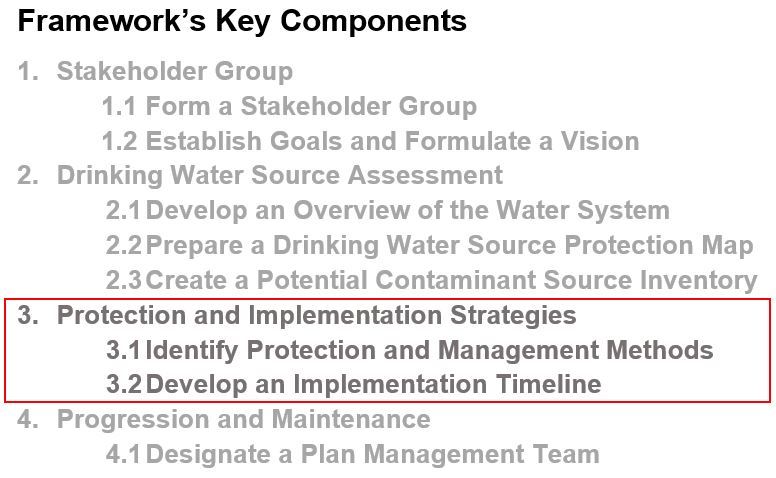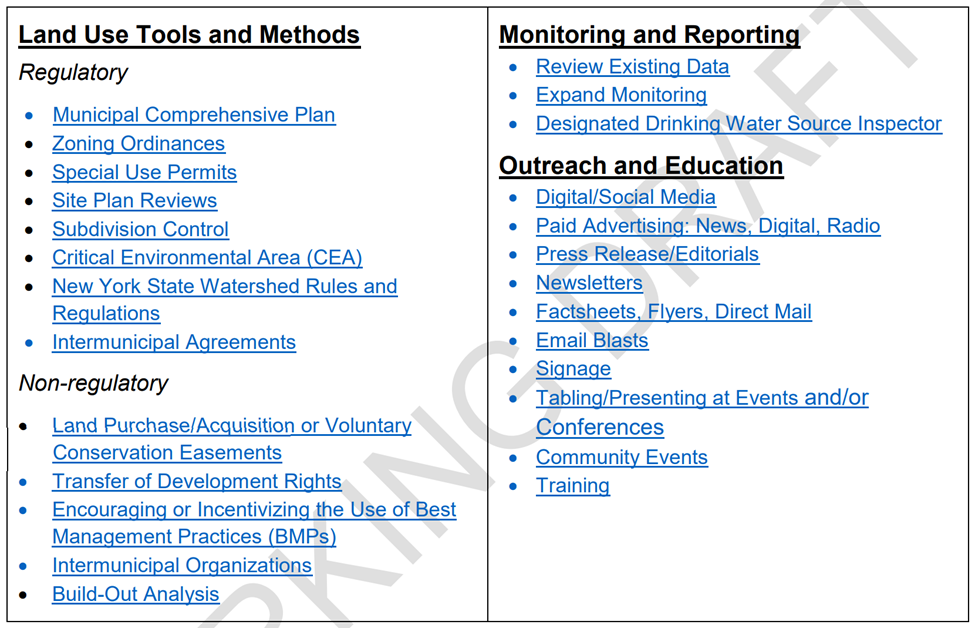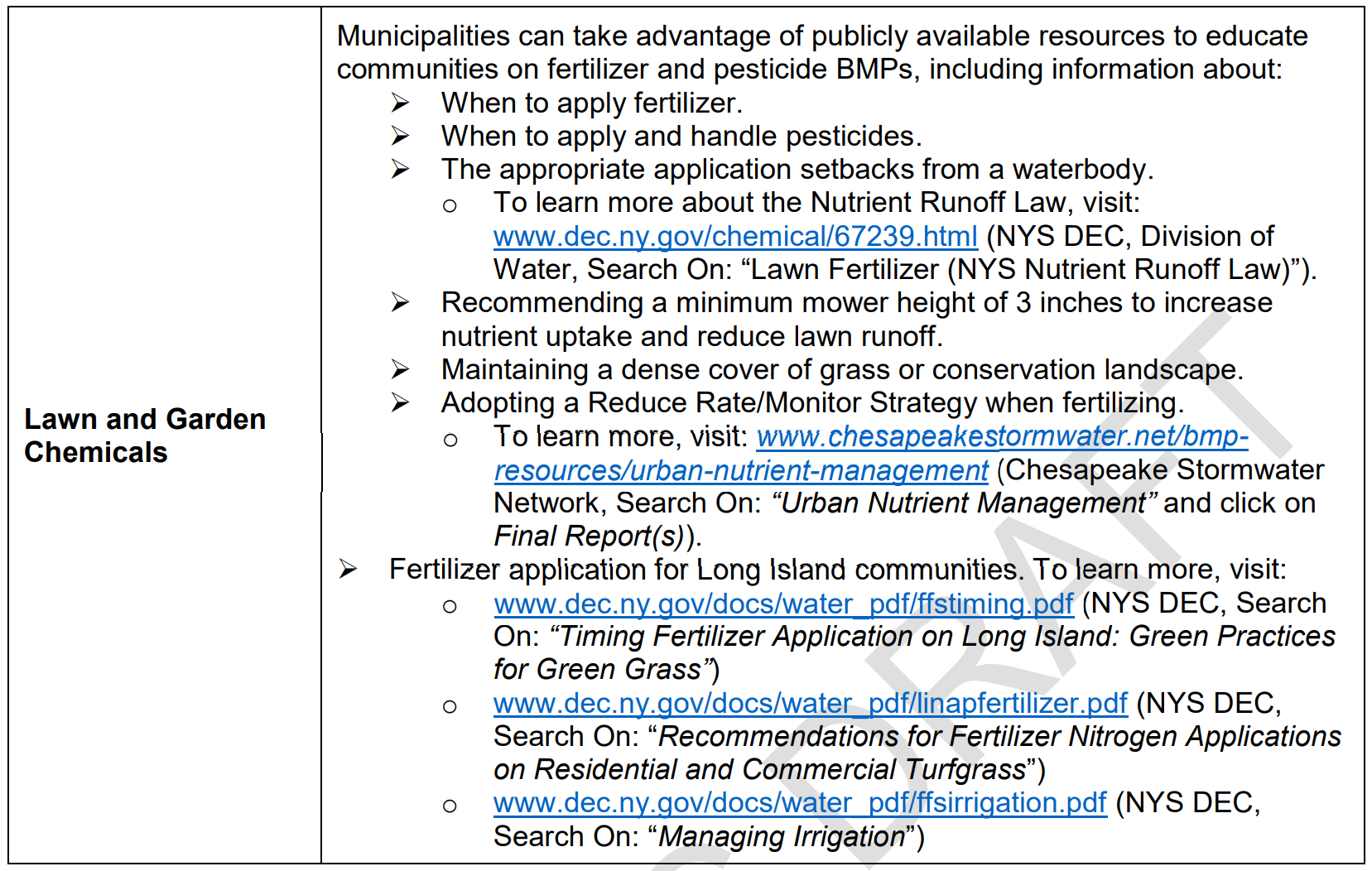Drinking Water Source Protection Program (DWSP2) - Monthly Newsletter
The New York State Department of Environmental Conservation sent this bulletin on 04/09/2021 02:16 PM EDT |
| DEC Delivers - Information to keep you connected and informed from the NYS Department of Environmental Conservation |
| Share or view as a web page || Update preferences or unsubscribe |
Drinking Water Source Protection Program - April Newsletter
This issue's topics:
- Source Water Buffer Program Grant Award
-
Phase 3 of the Framework for Creating a DWSP2 Plan
- 3.1 Identify Protection and Management Methods
- 3.2 Develop an Implementation Timeline
Source Water Buffer Program Grant AwardIn December 2020, the NYS State Soil and Water Conservation Committee awarded $82,894 through the Source Water Buffer Program to the Chautauqua County Soil and Water Conservation District to purchase a 6.4 acre conservation easement, exclude livestock from the easement area and protect 6.1 acres of herbaceous buffer. The easement will permanently protect agricultural land along a tributary of Chautauqua Lake. Chautauqua Lake serves as a source of public drinking water for approximately 8,000 people. The Source Water Buffer Program Award is just one example of available programs and/or grants to assist with the protection of source waters. We will continue to highlight these as we are aware of them. Let's continue our deeper dive into "A Framework for Creating a Drinking Water Source Protection Program Plan" as introduced in our December issue. Below is a synopsis of each of the four phases and eight key components of a protection plan. In today's issue, we will review Phase 3 of the DWSP2 Framework: Protection and Implementation Strategies.
3.1 Identify Protection and Management MethodsIn this issue, we will build on what you learned last month: how to prepare a drinking water source protection map and create a potential contaminant source inventory. These previous steps will help your municipality make educated decisions on selecting strategies to protect your community’s source water. But first,
What are protection and management methods?
These are strategies that can minimize risks posed to a community’s source water. Both protection and management methods can protect the drinking water supply against existing and future potential contaminant sources. However, they are different as described below.
What kind of protection and management methods are there?The Framework contains a variety of protection and management methods, and communities should utilize as many as needed. It is important to keep in mind that the lists in the Framework are not all-encompassing. Your community may need to utilize other methods to address a specific concern or meet a specific goal.
Protection MethodsAs you can see below, the methods are not specific to a potential contaminant source and can be utilized for existing and/or future potential contaminant sources.
A snapshot of Protection Methods List from Component 3.1 Identify Protection and Management Methods of the Framework Each protection method listed in the Framework has its own table with the following information:
Management MethodsEvery potential contaminant source listed in component 2.3 has its own set of management methods. They are either a step-by-step process and/or best management practices that a community can utilize to protect against an existing potential contaminant source.
A snapshot of the Lawn and Garden Management Method from Component 3.1 Identify Protection and Management Methods of the Framework Using my DWSP2 map and inventory to select the best methodsThe work your community did in the previous phase (prepare a drinking water source protection map, and create a potential contaminant source inventory) can aid with this component of the Framework. Communities can use their map and inventory to:
3.2 Develop an Implementation TimelineNow that we have identified methods, let’s build a plan that will help set the community up for success. All methods will need planning and possibly help from external resources to come to fruition. For each method, communities will need to think about:
Getting OrganizedLucky for the community, the State has created a DWSP2 Data Summary (introduced in the December newsletter) to aid with the collection and organization of this information. In addition to this tool, the Framework includes a number of examples and steps a community may want to take to have a complete implementation timeline.
A snapshot of component 3.1 Identify Protection and Management Methods and 3.2 Develop an Implementation Timeline from the DWSP2 Data Summary What resources are there to help with the cost of a protection or management method?Some of the selected methods may have implementation costs that are beyond what a community can cover. That doesn’t mean it isn’t possible! Our Toolkit has a list of over 20 state and federal funding sources for a community to apply for. We will also continue to pass along funding sources in this newsletter as we become aware of them.
Our next edition will be the last stop on our tour of the Framework with Phase 4: Progression and Maintenance. Share Your ThoughtsHave you begun this process? Or, do you have a program or are aware of a program relevant to source water? Send in any helpful hints or information at source.water@dec.ny.gov and we may highlight them! Sign UpTo sign-up for the DWSP2 newsletter, visit the DWSP2 webpage or click here. Newsletter ArchiveMissed last month’s edition? Visit the DWSP2 Newsletter Archive to stay up to date. |




